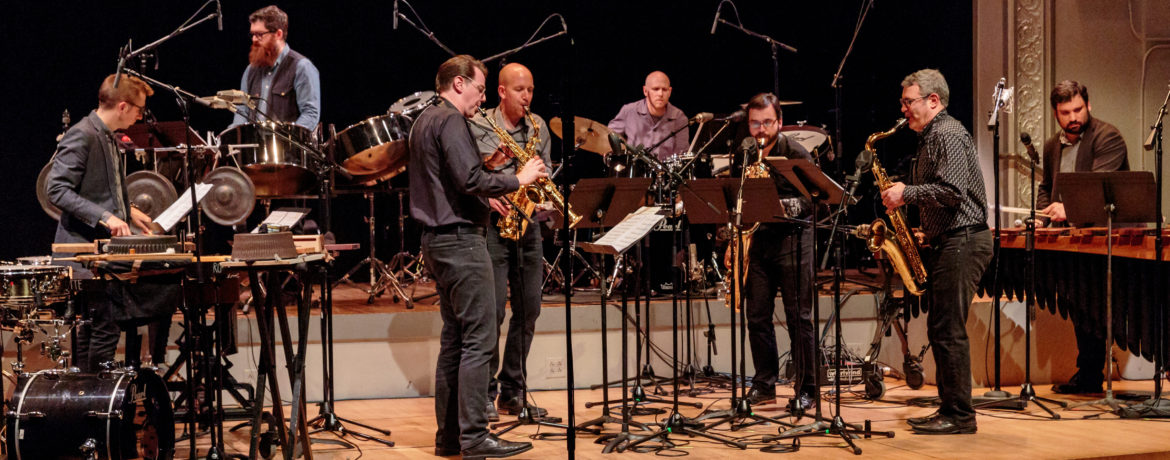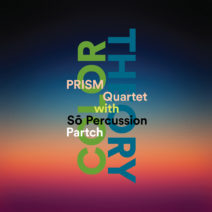Color Theory
Stream or download: choose your preferred music platform.
Music for Saxophones, Percussion and Harry Partch Instruments
Blue Notes and Other Clashes (2016) by Steven Mackey (b. 1956)
PRISM Quartet and Sō Percussion
Future Lilacs (2016) by Ken Ueno (b. 1970)
PRISM Quartet, Partch, Derek Johnson, Stratis Minakakis
Skiagrafies (2016) by Stratis Minakakis (b. 1979)
PRISM Quartet, Partch, Stratis Minakakis
Read/download the iTunes booklet
Read/download the one sheet
Behind-the scenes photos
Header photo by Scott Friedlander
UPC:
864190000215
Guest Artists:
Sō Percussion; Partch; Derek Johnson, adapted electric guitar; Stratis Minakakis, conductor
Record Label / Catalogue Number:
XAS 102
Release Date:
April 14, 2017
One Sheet
We have developed some pretty sophisticated ways of using language to describe music. But music remains such a slippery, elusive thing that we often find ourselves approaching it sideways—through a kind of linguistic sleight of hand. We use the language of the eye to describe this language of the ear: the names of major musical movements were taken from the visual arts (Classicism, Romanticism, Impressionism, Expressionism, Minimalism). And the metaphor of color has been used, to great effect, to talk about music for centuries, at least. In fact, the ancient classical music traditions of India are built on this metaphor: the word “raga” literally means “color.”
When the PRISM Quartet decided to commission a body of work built around the idea of musical colors, it seemed a natural next step for a group that has already created a substantial and diverse repertoire of music built around the almost infinitely variable sounds of the saxophone family. The sax has a long tradition in classical music, and rock, and even South Indian music; but its most famous players have been jazz musicians—from Coleman Hawkins to Charlie Parker to John Coltrane—whose sound was built around the so-called “blue” notes that are part of the fabric of jazz. So the members of the quartet had a deep connection with the idea of tone colors. But that wasn’t the Color Theory moment of genius. No, that came when PRISM decided to ask composers Steven Mackey, Ken Ueno, and Stratis Minakakis to write for the combination of saxophone quartet and percussion. There is no more kaleidoscopic palette in the instrumental world than in the percussion section—where over the years composers have placed such sonic oddities as bird calls, a record player, automobile parts, and the piano.
Color Theory pairs PRISM with two percussion-based ensembles: Sō Percussion, the New York-based quartet whose definition of “percussion” is liberal enough to include teacups, twigs, and fuzz; and Partch, the California-based ensemble that plays mid-20th century instruments designed by Harry Partch, whose 42-note-to-the-octave tuning system operates with a completely different sonic palette.
—John Schaefer
Funding Acknowledgement
Major support for Color Theory has been provided by The Pew Center for Arts & Heritage, with additional support from The Presser Foundation, the Alice M. Ditson Fund of Columbia University, and New Music USA, made possible by annual program support and/or endowment gifts from Mary Flagler Cary Charitable Trust, Rockefeller Brothers Fund, Anonymous.
Reviews
-
""an enviable combination of integrity, individuality, and instant appeal – no mean feat, given some of the more rigorous creative modes PRISM has investigated...Instant verdict: Mission accomplished. The PRISM players not only produce a positively beguiling range of tonal colors and shadings on their own, but also mix and mingle with their percussive cohorts in consistently rich and imaginative ways." Read the full review at : http://thelogjournal.com/2017/04/14/album-review-prism-quartet-color-theory/"
- Steve Smith, The Log Journal
-
"Ask any graphic design or fine arts graduate about colour theory and a discussion about colour contrast will invariably follow, so fundamental is it to the topic. Contrasts of hue, value, saturation, and temperature are routinely exploited in a visual context, but they're hardly exclusive to it, as PRISM Quartet's aptly titled Color Theory indicates; if anything, the album, which presents commissioned works built around the idea of musical colour, reveals how incredibly rich and plentiful a recording can be with respect to contrast. For starters, the quartet itself exemplifies colour contrast: though saxophone's the shared hue, value contrasts (light-dark) naturally emerge when the four play different kinds of saxophones, with Timothy McAllister on soprano, Zachary Shemon on alto, Matthew Levy on tenor, and Taimur Sullivan baritone (additional colour emerges during Ken Ueno's Future Lilacs when Shemon adds “hookah” saxophone to the performance). PRISM isn't alone on the recording, however, and it's here where other key contrasts apply: on Steven Mackey's Blue Notes and Other Clashes, the group's joined by the New York-based quartet So Percussion, whose members supplement PRISM's palette with an incredibly rich spectrum of their own; in addition to conventional instruments such as vibraphone, gongs, marimba, triangle, and bass drum, the group adds sounds of tin cans, vibraslap, steel drums, flexatone, and singing bowl to Mackey's piece. And yet as unusual as So Percussion's sound world is, the one the other ensemble, PARTCH, contributes to the recording's other settings is even more unusual; dedicated to performing and recording the work of Harry Partch (1901-1974), the seven-member, California-based ensemble plays instruments such as cloud chamber bowls, chromelodeon, diamond marimba, and kithara on two of the recording's three works (apparently, only three sets of Harry Partch instruments exist). Deepening the unconventional character of Partch's soundworld is the application of a forty-two-note-to-the-octave tuning system to his compositions; not surprisingly, contrasts of timbre, sonority, and pitch are in plentiful supply in these Partch pieces. Also appearing on the release are Derek Johnson, who plays adapted electric guitar on Ueno's Future Lilacs, and Stratis Minakakis, who conducted Ueno's piece and his own Skiagrafies, the third work featured. Such bold ventures are nothing new to a group who gives new meaning to the word intrepid. Every recording, it seems, finds PRISM exploring inspired ideas and adventurous territory; recent releases, for example, have seen the quartet partnering with the ensemble Music From China to play material by Chinese-born American composers (The Singing Gobi Desert) and collaborating with contemporary jazz artists Steve Lehman, Greg Osby, Miguel Zenón, and Dave Liebman on Heritage/Evolution, Volume 1. Issued on the group's recently launched XAS record label and recorded in June 2016, Color Theory is very much in line with the path the group's carved out for itself since its founding at the University of Michigan in 1984. Significantly more than an extended riff on the blues, Mackey's 2016 work Blue Notes and Other Clashes presents eight movements that in their titles pair adjectives usually used to describe colour with nouns denoting musical forms. At thirty-three minutes, it's arguably the dominant work of the three, though the arresting sound design of Ueno's Future Lilacs definitely puts it in the running. Mackey's suite is, predictably, bluesy at times, but as intimated by the track titles, contrasts of style and mood are generous in number. Inaugurating the recording on a crepuscular and rather subdued note, “Deep Hymn” derives much of its haunting character from the coupling of soprano sax, steel pans, and marimba, the tonal contrasts striking yet complementary for all that. Rambunctious by comparison is “Rustic Ballad,” which sees drums, marimba, steel drums, and saxes in constant motion as the two quartets spar, while Stravinsky-ites will take delight in hearing snippets of the “March” from L'Histoire du Soldat wend their way into the intricate goings-on of “Mottled March.” One final contrast involves length: whereas the first seven parts are modest in duration, the eighth, “Prismatic Fantasy,” ventures far and wide during its eleven action-packed minutes. Ueno's Future Lilacs lunges into action with an unaccompanied Johnson playing an electrified version of Partch's adapted guitar, the instrument rich in heavy metal-like distortion and functioning as a tonal center around which the other instruments gradually gather. A high-energy and oft-fractious dialogue ensues between the guitar, percussion, and saxophones until the storm lifts midway through and Shemon's “hookah” sax (which replaces the alto's brass neck with seven feet of rubber hose) replaces Johnson's guitar as the focal point. Arriving as it does after the frenetic pitch of the first half, the spacious, gamelan-like second feels all the more meditative and peaceful as a result. Overshadowed by the other two, Stratis Minakakis's Skiagrafies (Greek for ‘shadow etchings') is the least memorable of the three compositions, even if the PARTCH ensemble's sonorities are as ear-catching here as they are in Ueno's. Though there's a rather sickly quality to the material, due in part to the lurch with which it advances and the unsettling clash of the tunings, the sound design can't help but fascinate when its arrangement includes adapted viola, bass and diamond marimbas, and cloud chamber bowls. Among the many things to recommend about Color Theory is PRISM's willingness to share the stage with others. Never does the recording feel like a group recording featuring guests but instead fully integrated ensemble performances wherein PRISM and its collaborators blend magnificently. The quartet always performs in service to the music in play, yet distinguishes itself all the more for realizing its diverse projects with humility. July 2017 Originally posted at: http://textura.org/archives/p/prismquartet_colortheory.htm"
- textura
-
""The PRISM Quartet consists of saxists Timothy McAllister/ss, Zachary Shemon/as, Matthew Levy/ts and Taimure Sullivan, and they team up on this album with various guests including the percussive teams So Percussion and Partch, electric guitarist Derek Johnson and conductor Stratis Minakakis. The eight part “Blue Notes and Other Clashes has the So Percussion team joining in with the four saxes for some steel drums, kalimba and other things that go bump in the night while the reeds brood, create rich vibrato sand hover. The thirty two minutes include much variation of percussion discussions, while the twenty two minute “Future Lilacs” has the Partch ensemble team up with electric guitarist Derke Johnson for some rocking distortion teamed with space and tubular bells, sounding like a lonely harbor buoy at night clanging away. The final “Skiagrafies” has the reeds hover over a stagnant pulse of a rhythm like a morning fog." Read the full review at: http://www.jazzweekly.com/2017/08/free-and-looseanemone-a-wing-dissolved-in-light-klaus-treuheit-lou-grassiport-of-call-prism-quartet-color-theory/"
- Jazz Weekly





